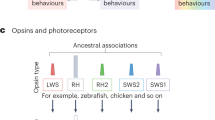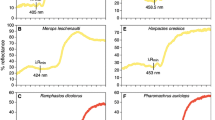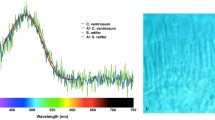Abstract
The potential for color vision in elasmobranchs has been studied in detail; however, a high degree of variation exists among the group. Evidence for ultraviolet (UV) vision is lacking, despite the presence of UV vision in every other vertebrate class. An integrative physiological approach was used to investigate color and ultraviolet vision in cownose rays and yellow stingrays, two batoids that inhabit different spectral environments. Both species had peaks in UV, short, medium, and long wavelength spectral regions in dark-, light-, and chromatic-adapted electroretinograms. Although no UV cones were found with microspectrophotometric analysis, both rays had multiple cone visual pigments with λ max at 470 and 551 nm in cownose rays (Rhinoptera bonasus) and 475, 533, and 562 nm in yellow stingrays (Urobatis jamaicensis). The same analysis demonstrated that both species had rod λ max at 500 and 499 nm, respectively. The lens and cornea of cownose rays maximally transmitted wavelengths greater than 350 nm and greater than 376 nm in yellow stingrays. These results support the potential for color vision in these species and future investigations should reveal the extent to which color discrimination is significant in a behavioral context.





Similar content being viewed by others
Abbreviations
- DW:
-
Disc width
- ERG:
-
Electroretinogram
- FWHM:
-
Full width at half maximum
- LWS:
-
Long wavelength sensitive pigment
- MSP:
-
Microspectrophotometry
- MWS:
-
Medium wavelength sensitive pigment
- SWS:
-
Short wavelength sensitive pigment
- T 0.5 :
-
Wavelength at 0.5 normalized transmittance
- UV:
-
Ultraviolet
- λ max :
-
Wavelength of maximum absorbance
References
Ajemian MJ, Powers SP (2012) Habitat-specific feeding by cownose rays (Rhinoptera bonasus) of the northern Gulf of Mexico. Environ Biol Fish 95:79–97
Allen E, Fernald R (1985) Spectral sensitivity of the African cichlid fish, Haplochromis burtoni. J Comp Physiol A 157:247–253
Barlow R Jr (1985) Spectral sensitivity of the Japanese dace electroretinogram. In: Fein A, Levine J (eds) The visual system. Alan R Liss, Inc., New York, pp 57–60
Bedore CN (2013) Visual and electrosensory ecology of batoid elasmobranchs. Dissertation, Florida Atlantic University
Bowmaker JK, Thorpe A, Douglas RH (1991) Ultraviolet-sensitive cones in the goldfish. Vis Res 31:349–352
Bowmaker JK, Govardovskii VI, Shukolyukov SA, Zueva LV, Hunt DM, Sideleva VG, Smirnova OG (1994) Visual pigments and the photic environment: the cottoid fish of Lake Baikal. Vis Res 34:591–605
Bridges CDB (1965) The groupings of fish visual pigments about preferred positions in the spectrum. Vis Res 5:223–228
Burkhardt D (1966) The goldfish electroretinogram: relation between photopic spectral sensitivity functions and cone absorption spectra. Vis Res 6:517–532
Cheney KL, Skogh C, Hart NS, Marshall NJ (2009) Mimicry, colour forms and spectral sensitivity of the bluestriped fangblenny, Plagiotremus rhinorhynchos. Proc R Soc Lond B Biol Sci 276:1565–1573
Chiao C–C, Cronin TW, Marshall NJ (2000) Eye design and color signaling in a stomatopod crustacean Gonodactylus smithii. Brain Behav Evol 56:107–122
Clark E (1963) The maintenance of sharks in captivity, with a report on their instrumental conditioning. In: Gilbert PW (ed) Sharks and survival. D.C. Heath, Boston
Cohen JL, Gruber SH (1977) Spectral sensitivity and Purkinje shift in the retina of the lemon shark, Negaprion brevirostris (Poey). Vis Res 17:787–792
Cohen JL, Gruber SH (1985) Spectral input to lemon shark (Negaprion brevirostris) ganglion cells. J Comp Physiol A 156:579–586
Cohen JL, Hueter RE, Organisciak DT (1990) The presence of a porphyropsin-based visual pigment in the juvenile lemon shark (Negaprion brevirostris). Vis Res 30:1949–1953
Collin SP, Trezise AEO (2004) The origins of colour vision in vertebrates. Clin Exp Optom 87:217–233
Collins AB, Heupel MR, Hueter RE, Motta PJ (2007a) Residence and movement patterns of cownose rays Rhinoptera bonasus within a southwest Florida estuary. J Fish Biol 71:1159–1178
Collins AB, Heupel MR, Hueter RE, Motta PJ (2007b) Hard prey specialists or opportunistic generalists? An examination of the diet of the cownose rays Rhinoptera bonasus. Mar Freshw Res 58:135–144
Collins AB, Heupel MR, Simpendorfer CA (2008) Spatial distribution and long-term movement patterns of cownose rays Rhinoptera bonasus within an estuarine river. Estuar Coasts 31:1174–1183
Compagno LJV, Last PR (1999) FAO species identification guide for fishery purposes. In: Carpenter KE, Niem VH (eds) The living marine resources of the Western Central Pacific, vol 2. Batoid fishes, chimaeras and bony fishes part 1 (Elopidae to Linophrynidae). FAO, Rome
Dearry A, Barlow Jr. RB (1987) Circadian rhythms in the green sunfish retina. J Gen Physiol 89:745–770
Douglas RH, McGuigan CM (1989) The spectral transmission of freshwater teleost ocular media- an interspecific comparison and a guide to potential ultraviolet sensitivity. Vis Res 29:871–879
Fahy DP (2004) Diel activity patterns, space utilization, seasonal distribution and population structure of the yellow stingray, Urobatis jamaicensis (Cuvier, 1817) in South Florida with comments on reproduction. MSc Thesis, Nova Southeastern University
Frank TM, Porter M, Cronin TW (2009) Spectral sensitivity, visual pigments and screening pigments in two life history stages of the ontogenetic migrator Gnathophausia ingens. J Mar Biol Assoc UK 89:119–129
Griebel U, Schmid A (1992) Color vision in the California sea lion (Zalophus californianus). Vis Res 32:477–482
Griebel U, Schmid A (2002) Spectral sensitivity and color vision in the bottlenose dolphin (Tursiops truncatus). Mar Freshw Behav Physiol 35:129–137
Gruber SH (1975) Duplex vision in the elasmobranchs: histological, electrophysiological and psychophysical evidence. In: Ali MA (ed) Vision in fishes: new approaches in research. Plenum Press, New York, pp 525–540
Gruber SH, Hamasaki DI, Bridges CDB (1963) Cones in the retina of the lemon shark (Negaprion brevirostris). Vis Res 3:397–399
Gruber SH, Loew ER, McFarland WN (1991) Rod and cone pigments of the Atlantic guitarfish, Rhinobatos lentiginosus Garman. J Exp Zool Suppl 5:85–87
Hamasaki DI, Gruber SH (1965) The photoreceptors of the nurse shark, Ginglymostoma cirratum and the stingray, Dasyatis sayi. Bull Mar Sci 15:1051–1059
Hart NS, Lisney TJ, Marshall NJ, Collin SP (2004) Multiple cone visual pigments and the potential for trichromatic colour vision in two species of elasmobranch. J Exp Biol 207:4587–4594
Hart NS, Theiss SM, Harahush BK, Collin SP (2011) Microspectrophotometric evidence for cone monochromacy in sharks. Naturwissenschaften 98:193–201
Hazlett BA (1979) The meral spot of Gonodactylus oerstedii Hansen as a visual stimulus (Stomatopoda, Gonodactylidae). Crustaceana 36:196–198
Jacobs GH (1981) Comparative color vision. Academic, New York
Jacobs GH, Deegan JF II, Neitz J, Crognale MA, Neitz M (1993) Photopigments and color vision in the nocturnal monkey, Aotus. Vis Res 33:1773–1783
Jerlov NG (1976) Marine optics. Elsevier, Amsterdam
Kelber A, Roth LS (2006) Nocturnal colour vision- not as rare as we might think. J Exp Biol 209:781–788
Last PR, Stevens JD (1994) Sharks and rays of Australia. CSIRO, Australia
Levine JS, MacNichol EF Jr (1982) Color vision in fishes. Sci Am 246:108–117
Lisney TJ, Theiss SM, Collin SP, Hart NS (2012) Vision in elasmobranchs and their relatives: 21st century advances. J Fish Biol 80:2024–2054
Loew ER (1994) A third, ultraviolet-sensitive, photopigment in the Tokay gecko, Gekko gecko. Vis Res 34:1427–1432
Loew ER, Lythgoe JN (1978) The ecology of cone pigments in teleost fishes. Vis Res 18:715–722
Losey GS, Cronin TW, Goldsmith TH, Hyde D, Marshall NJ, McFarland WN (1999) The UV visual world of fishes: a review. J Fish Biol 54:921–943
Losey GS, McFarland WN, Loew ER, Zamzow JP, Nelson PA, Marshall NJ (2003) Visual biology of Hawaiian coral reef fishes. I. Ocular media transmission and visual pigments. Copeia 3:433–454
Lythgoe JN (1972) The adaptation of visual pigments to their photic environment. In: Dartnall HJA (ed) Handbook of sensory physiology, Vol. VII/1. Springer, Berlin, Heidelberg, New York, pp 566–603
Lythgoe JN, Muntz WRA, Partridge JC, Shand J, Williams DM (1994) The ecology of the visual pigments of snappers (Lutjanidae) on the Great Barrier Reef. J Comp Physiol A 174:461–467
Marshall NJ, Vorobyev M (2003) The design of color signals and color vision in fishes. In: Collin SP, Marshall NJ (eds) Sensory processing in aquatic environments. Springer, New York
Marshall NJ, Jones JP, Cronin TW (1996) Behavioural evidence for colour vision in stomatopod crustaceans. J Comp Physiol A 179:473–481
McComb DM, Kajiura SM (2008) Visual fields of four batoid fishes: a comparative study. J Exp Biol 211:482–490
McComb DM, Frank TM, Hueter RE, Kajiura SM (2010) Temporal resolution and spectral sensitivity of the visual system of three coastal shark species from different light environments. Physiol Biochem Zool 83:299–307
McEachren JD, de Carvahlo MR (2002) FAO species identification guide for fishery purposes. In: Carpenter KE (ed) The living marine resources of the western central Atlantic, vol 1. Introduction, Molluscs, Crustaceans, Hagfishes, Sharks, Batoid Fishes and Chimaeras. FAO, Rome
Muntz WRA, Church E, Dartnall HJA (1973) Visual pigment of the freshwater stingray, Paratrygon motoro. Nature 246:517
Munz FW, McFarland WN (1973) The significance of spectral position in the rhodopsins of tropical marine fishes. Vis Res 13:1829–1874
Munz FW, McFarland WN (1977) Evolutionary adaptations of fishes to the photic environment. In: Crescitelli F (ed) The visual system in vertebrates. Handbook of sensory physiology, vol VII/5. Springer, Berlin, Heidelberg, New York, pp 193–274
Neer JA, Thompson BA (2005) Life history of the cownose ray, Rhinoptera bonasus, in the northern Gulf of Mexico, with comments on geographic variability in life history traits. Environ Biol Fish 73:321–331
Nelson PA, Kajiura SM, Losey GS (2003) Exposure to solar radiation may increase ocular UV-filtering in the juvenile scalloped hammerhead shark, Sphyrna lewini. Mar Biol 142:53–56
O’Gower AK, Mathewson RF (1967) Spectral sensitivity and flicker fusion frequency of the lemon shark, Negaprion brevirostris. In: Gilbert PW, Mathewson RF, Rall DP (eds) Sharks, skates, and rays. Johns Hopkins Press, Baltimore, pp 433–446
Orth RJ (1975) Destruction of eelgrass, Zostera marina, by the cownose ray, Rhinoptera bonasus, in the Chesapeake Bay. Chesap Sci 16:205–208
Partridge JC, Cuthill IC (2010) Animal behaviour: ultraviolet fish faces. Curr Biol 20:R318–R320
Ripps H, Dowling JE (1991) Structural features and adaptive properties of photoreceptors in the skate retina. J Exp Zool Suppl 5:46–54
Schultze M (1866) Zur anatomie und physiologie der retina. Arch mikr Anat 2:175–286
Siebeck UE (2004) Communication in coral reef fish: the role of ultraviolet colour patterns in damselfish territorial behaviour. Anim Behav 68:273–282
Siebeck UE, Marshall NJ (2001) Ocular media transmission of coral reef fish-can coral reef fish see ultraviolet light? Vis Res 41:133–149
Siebeck UE, Wallis GM, Litherland L (2008) Colour vision in coral reef fish. J Exp Biol 211:354–360
Siebeck UE, Parker AN, Sprenger D, Mäthger LM, Wallis G (2010) A species of reef fish that uses ultraviolet patterns for covert face recognition. Curr Biol 20:407–410
Smith JW, Merriner JV (1985) Food habits and feeding behavior of the cownose ray, Rhinoptera bonasus, in Chesapeake Bay. Estuaries 8:305–310
Smith JW, Merriner JV (1987) Age and growth, movements and distribution of the cownose ray, Rhinoptera bonasus, in Chesapeake Bay. Estuaries 10:153–164
Stell WK (1972) The structure and morphologic relations of rods and cones in the retina of the spiny dogfish, Squalus. Comp Biochem Physiol 42A:141–151
Tester AL, Kato S (1966) Visual target discrimination in blacktip sharks (Carcharhinus melanopterus) and grey sharks (C. menisorrah). Pac Sci 20:461–471
Theiss SM, Lisney TJ, Collin SP, Hart NS (2007) Colour vision and visual ecology of the blue-spotted maskray, Dasyatis kuhlii Muller & Henle, 1814. J Comp Physiol A 193:67–79
Toyoda JI, Saito T, Kondo H (1978) Three types of horizontal cells in the stingray retina: their morphology and physiology. J Comp Neurol 179:569–579
Van-Eyk SM, Siebeck UE, Champ CM, Marshall J, Hart NS (2011) Behavioural evidence for colour vision in an elasmobranch. J Exp Biol 214:4186–4192
von Kries J (1894) Über den Einfluss der Adaptation auf Licht und Farbenempfindung und über die Funktion der Stäbchen. Ber Naturforsch Ges. Freiburg 9:61–70
Walls GL (1942) The vertebrate eye and its adaptive radiation. Hafner, New York
Ward-Paige CA, Pattengill-Semmens C, Myers RA, Lotze HK (2011) Spatial and temporal trends in yellow stingray abundance: evidence from diver surveys. Environ Biol Fish 90:263–276
Wartzok D, McCormick MG (1978) Color discrimination by a Bering Sea spotted seal, Phoca largha. Vis Res 18:781–784
Witkovsky P (1968) The effect of chromatic adaptation on color sensitivity of the carp electroretinogram. Vis Res 8:823–837
Zigman S (1971) Eye lens color: formation and function. Science 171:807–809
Acknowledgments
The authors thank the FAU Elasmobranch Research Laboratory, J. DelBene, J. Gardiner, and J. Morris for collection, husbandry, and technical support, and N. Hart, C. Luer, A. Stamper, R. Brill, A. Horodysky, D. Fahy, and A. Henningson for logistical support and advice. Funding was awarded to CNB by the American Elasmobranch Society Student Research Award and Mollet Elasmobranch Research Award, Sigma Xi Grants-in-Aid of Research, and FAU Graduate College Newell Doctoral Fellowship. All experiments were conducted in accordance with Institutional Animal Care and Use Committee (IACUC) approved protocols from Florida Atlantic University (A09-25, A12-11, A12-33) and Mote Marine Laboratory (12-09-SK1).
Conflict of interest
The authors declare that they have no conflict of interest.
Author information
Authors and Affiliations
Corresponding author
Additional information
Experiments comply with the current laws of the country (USA) in which they were performed.
Rights and permissions
About this article
Cite this article
Bedore, C.N., Loew, E.R., Frank, T.M. et al. A physiological analysis of color vision in batoid elasmobranchs. J Comp Physiol A 199, 1129–1141 (2013). https://doi.org/10.1007/s00359-013-0855-1
Received:
Revised:
Accepted:
Published:
Issue Date:
DOI: https://doi.org/10.1007/s00359-013-0855-1




